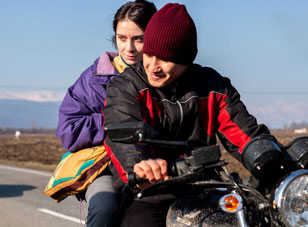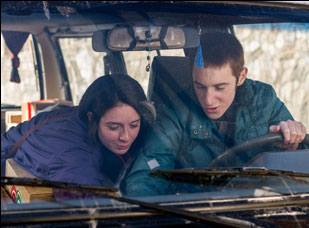After her 2016 debut feature “Sofichka,” Kira Kovalenko had traveled to South Ossetia to be inspired for her second, passing through the mining town of Mizur where besides the hydropower plant in the middle, there was limited currency to speak of. The writer/director imagined being restless in such an area, once considering the story of a trio of brothers and their father set in the region, but having her attention drift to what it would be like for a young woman to grow up where two Chechen wars have shaped generations to fear straying far from their families yet only marriage is a viable path to putting distance between oneself and their relatives. Kovalenko, a disciple of the same intensive filmmaking workshop conducted by the master Alexandr Sokurov that recently produced “Beanpole” director Kantemir Balagov — and both would find a home for their second film at “Loveless” producer Alexander Rodyansky’s Non-Stop Productions, naturally immersed herself in Mizur, not entirely fluent in the language, but picking up on all of its cultural specificities to the point that when she arrived at the Grand Palais in Cannes where “Unclenching the Fists” would premiere this past weekend, she was understandably reticent to see it as the end of a journey.
“I was worried,” said Kovalenko, hours after the film’s debut. “It was very hard for me to let go.”
Not as hard as it will be for audiences as Kovalenko’s magnificent drama grabs one from its opening frame and refuses to let go, introducing Adadza (Milana Aguzarova) as she’s tucked behind a corner ready to make her way out into the world. Ostensibly, she is on the clock, there to await a delivery from Tamik (Arsen Khetagurov), a driver around her age whose obvious interest in her has not gone unnoticed, but unrequited when she remains tethered to taking care of her younger brother Dakko and her father Zaur after her older brother Akim was fortunate enough to leave Mizur some time ago. He reluctantly shows up on the occasion of Zaur’s birthday, but rather than bring cheer, the visit exposes how the entire family is paralyzed in a state of arrested development that began with the death of the family’s matriarch years ago, putting Zaur in the unwelcome position of raising children he unprepared to tend to and Ada under his thumb while attempting to care for Dakko, who deals with a slight mental illness, and keeping connected to Akim.
“Unclenching the Fists” may find Ada at a standstill, but Kovalenko not only draws on an impressive performance from Aguzarova to convey her active inner life, but expresses the pressure put upon her and her desire to push back against it in long, fluid takes involving extraordinary choreography and evocative framing that viscerally bring her struggle to the surface. Inhibited by the past in ways she can’t fully understand given her age, but feels deeply every day when it has left some literal scars on her, Ada is wrestling with adversaries she’s can’t necessarily see beyond her aging, conservative father yet Kovalenko illuminates them brilliantly by summoning such a strong sense of place and of the family she trains her lens on, letting them break through the screen. Following the film’s world premiere on the Croisette as part of the prestigious Un Certain Regard selection, Kovalenko spoke, with the help of an interpreter, about how she was able to craft such a powerful drama, allowing her cast to bring themselves into the story and the authenticity that gives “Unclenching the Fists” such strength.

Let me quote William Faulkner as an answer to your question — he says, “A man is a sum of his memories and the sum of his past” but I was trying to be delicate as possible and give my story more depth so that this historical context would not outweigh this human drama. I saw this setting [of Mizur, a mining town] and I went there and I wanted to explore it. The story of the film was mostly born in this setting and what happened onscreen was dependent on what I felt and experienced in that place. This place looked and felt to me as if it was blocks on which you could put something that is precious to you or you could hide something.
The film is very vivid in its color scheme and far from the dusty depiction you usually see of rural areas. How were the film’s visuals inspired by the environment?
I started with people, I tried to categorize what kind of clothes they wear, what kind of colors they choose and how color plays a presence in their daily life and to base my film on their own choices on the realities of their life. I believe that people who are living in places like this and conditions like this try to use color as a defense mechanism, so I tried to let my characters help themselves with color, with their choices of color.
I’ve read the actors actually wore their own wardrobe…
All the primary characters were not wearing their own wardrobe – that was costumes, but for the parts I wanted to be played by nonprofessional actors, I tried to cast them in a way that the person I’d choose would closely resemble somebody I wrote in the script, but it was not that I chose them, it was like I met them.
One of the most striking elements of the film is how physicality, body language and movement are as communicative as the dialogue – is that something you’re working out at a script stage or do you start seeing things once you’re working with the actors?
Part of that physicality was already in the script. I wanted the viewer to feel the suffocation of the embrace I was depicting and a lot of that depended on the characters and how I imagined them with their specific character traits. With our protagonist, that was all about how she felt about herself physically, but I wanted her to come off as fractured. It was important for me to show.

Well, the first goal was artistic. No one other than Milana had to know what was going on with her — what she felt and how she felt and what was going to happen — so that we can film their reactions as objectively as possible and because most of the actors are not professionals, it was really important for me that they know nothing outside of the scenes they are playing at the moment.
This may be a silly question to end on, but so many intense scenes that happen in cars and moving vehicles – was it difficult to get what you wanted from such tight spaces?
Mostly that was because in real life, this region is a place where you don’t have many options in terms of entertainment or how to spend their time. Most young people really spent most of their free time driving because this is entertainment, but the choice of the car was intentional. I was specifically looking for a three-door vehicle so that my character is always sitting in the backseat where she cannot make the choice and just leave herself because she physically can’t. There are no doors.
“Unclenching the Fists” will screen at Cannes as part of Un Certain Regard on July 11th at Cineum Aura at 12:30 pm and Soixantieme Theatre at 5:30 pm.




